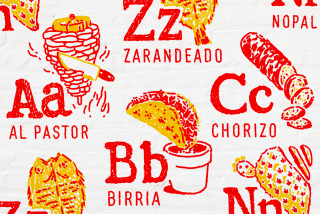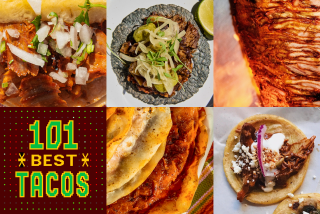Holy Smoke and Great Barbecue : Cooking: The real stuff requires low temperature, smoke and lots of time.
Barbecue rises like a plume of hardwood smoke above the esoteric foods of America. And like good barbecue, this didn’t happen fast. It probably started when the first pigs walked ashore at Jamestown in 17th-Century Virginia. Barbecue, in fact, might just be a 400-year-old argument.
What makes it good when it is good? Real when it is real? With all the time it takes to produce credible barbecue over the lowest imaginable fire, there is certainly time for debate to abound, which has only added to a certain, smoky mystique sauced in a Southern accent.
I have eaten good barbecue--pork shoulder, ribs, beef brisket, links, chicken--and frankly, as long as the eating pleasure is intense, I could care less if it is barbecue cooked in the Kansas City style or the Memphis style, the Texas style or the western half of North Carolina style, or the eastern half, for that matter. Chinese barbecue is fine by me.
While eating, I have had occasion to listen in on ponderous discourses on the subject of barbecue, much of which concerns how it is accomplished, and I have always wandered away, sucking my fingertips, wondering what all the fuss could possibly be about.
Barbecue is simply low temperature, smoke and lots of time. The only difference is going to be in the rub of spices or the marinade you apply to the meat before it goes into the pit, and the basting sauce you apply while it cooks, and the barbecue sauce you bring to the table with the finished product falling off the bone. I had been lost with such thoughts, but now I’m found; I was blind, but now I see.
If God is a barbecue pit, He arrived on a truck from Texas. And I’m not talking about some kind of enamel-coated grill stored out on the lanai next to the hibachi. No sir. This pit is simply too big, too heavy, too there. Assembled, the Hondo Smoker, as it is called, has all the look of an answered prayer: two sleek black barrels mounted end to end, one offset from the other, standing waist-high on sturdy legs and wheels. In whole, 160 pounds of arc-welded 12-gauge rolled-steel magnificence.
This pit is a piece of business, a child of the Texas oil fields, a tool-lover’s tool. My grandfather would have called it a peach. Simply stated, the Hondo Smoker provides a means of convection cooking that prevents pork ribs, chickens, sausages, beef briskets, rolled roasts, tri-tips, turkeys, legs of lamb or any manner of game from ever seeing the flame, ever feeling the direct lick of fire. The meat simply basks within the natural currents of heat and smoke, which is as it should be.
There are those who say real barbecue occurs below the boiling point of water, which at sea level is 212 degrees. These cooks work a subtle territory found between 180 and 210 degrees. Seasoned pitmasters, I am told, simply extend an open palm over the fire and know when it is right. Other cooks prefer to work at higher barbecue temperatures, 225 to 240 degrees, giving up a bit of that hot-juices-running-off-the-elbow succulence in exchange for shorter cooking times and better protection against bacteria.
All of this points in the direction of the obvious: Real barbecue and charcoal-grilling have only fire in common. Pieces of chicken can be grilled up and plopped on the dinner plate within 30 minutes. Barbecued chicken is going to languish in a pit such as the Hondo Smoker for at least 30 to 40 minutes per pound, often longer. A whole bird can take four to six hours. A tender beef brisket (at best, an oxymoron) will cook from one end of the day to the other.
Though alone at the time, I was more than a little smug when I first set to cooking some real barbecue in my virgin pit. I prepared a North African rub of ginger, cardamom, coriander, fenugreek, cloves, cinnamon, allspice, onion, garlic, salt, paprika, crushed hot red pepper and cracked black peppercorns and I massaged all that into three sirloin tip roasts.
As they slow-cooked in the pit I sprayed them with a highly aromatic Ethiopian butter-oil mixed with water and vinegar. I chuckled to myself. I congratulated myself. Barbecue indeed. I had the rig. I had the right selection of woods. I had the will. I had the time. I even thought I had the temperature under control.
What I didn’t have, as it turned out, was the esoteric part, the right touch. My first efforts at real barbecue tasted like petroleum-laced meat dragged through the back of a fireplace.
Ron Snyder, president of the New Braunfels Smoker Co. (P.O Box 310096, New Braunfels, Tex. 78131) and manufacturer of the Hondo Smoker, listened patiently as I described how I had arrived at a minimal fire technique, using only enough charcoal and the occasional stick of hardwood to keep the pit at 200 to 210 degrees while giving up only enough smoke to flavor, not obliterate, the meat.
“I just fill that firebox right up, myself,” Ron replied. “I burn the same kind of short mesquite logs I would burn in my fireplace. I just start the fire, and then I control the temperature with the baffle on the smokestack and on the firebox door.” Oh.
Much of Southern barbecue is wedded to mesquite, hickory and oak. While the Pacific Northwest has no regional tradition of barbecue, it does have alder and various fruit woods, and as the popularity of do-it-your-own-self barbecue takes hold, a distinct, regional flavor will no doubt emerge.
One Texas company specializes in packaging boxes of fist-sized chunks of dried mesquite and hickory, calling the product Cookin Chunks (WW Wood, Inc., P.O. Box 244, Pleasanton, Tex. 78064). The intent of the manufacturer is to replace charcoal briquettes with hardwood, or at least carve out a comfortable niche in the vain attempt.
One is forced to wonder what barbecue or grilled food tasted like before Henry Ford invented charcoal briquettes. Those of us who have grown up in the era of the briquette and have lived through any number of gizmos to get the fire started have had our sense of grill flavor, of what tastes right, shaped by a man-made, clay-bound industrial product.
Chunks of hardwood burn at a higher temperature, last longer and ignite faster than charcoal briquettes. As a result, you use less wood than briquettes when you grill. But you get that same seared quality on steaks and chops, poultry and fish with the addition of a slightly smoked undercarriage. Giving up the briquette for hardwood (soft woods like pine and fir are anathema to good grilling and ruin barbecue) may be too dramatic a departure for most of us, in which case mesquite chunk charcoal offers a credible alternative.
Wallowing around there at the base of the barbecue learning curve I struggled with frustration and levels of self-doubt I never knew existed. I had achieved enough success with the grill that I could take a $50 piece of meat and slap it over coals and not worry, guests arriving and all. But not barbecue. I would buy meat, do this, do that, and produce food only vaguely associated with real barbecue, most of it barely palatable.
Had it never come together, had the light never shone through, I might have quietly, meekly quit, thrown a tarp over the pit and forevermore listened with deep and abiding respect as wiser men discussed the merits of real barbecue and how they arrived at such vaunted results. Like any tormented and confused would-be pitmaster, I consulted the I Ching. It said, “Perseverance furthers.”
It rained the afternoon I finally achieved a little success at the pit and knew that all the past effort, all that wood and charcoal and meat, had elevated me a notch up the curve. When I lifted the lid, the racks of ribs and halved chickens glowed with the suggestion of done-rightness. The smell wafted up and circled my head, twice.
I looked over my shoulder for the rainbow, the sign of the covenant, because I could tell that all was well on earth, just like it is in heaven. Everything converged and took assigned seats without even being asked--time, space, fire, temperature control, smoke, texture, flavor and friends.
And at the moment of purest epiphany, when I knew in a way that precedes vocabulary why it is I follow the learning curve of barbecue, I heard the sound. Other regions of the nation may have fervently defended styles of barbecue, but the Pacific Northwest is unique for having the sound of good barbecue. It is a kind of hiss, a kind of pop, rapidly repeating in a random fashion with no syncopation; just like rain hitting the hot steel of a patio pit.
(From “Fire and Smoke” by Maggie Waldron, Ortho Publications, 1989)
Note: When I use it as a rub, I sprinkle Berbere on the meat, then dribble on some peanut oil or Nitr Kibe to make a smooth paste and marinate the meat in the refrigerator overnight. A much spicier, though equally delicious, version of Berbere can be found in John Schlesinger’s fabulous new book, “The Thrill of the Grill” (William Morrow & Co., 1990).
BERBERE
(Red Pepper Paste)
1 teaspoon ground ginger
1/2 teaspoon ground cardamom
1/2 teaspoon ground coriander
1/2 teaspoon fenugreek seeds
Dash mixed spices: ground cloves, cinnamon and allspice
2 teaspoons minced onion
1 clove garlic, crushed
1 tablespoon salt
1/4 cup paprika
1 tablespoon crushed hot red pepper flakes
1 teaspoon cracked peppercorns
Combine ginger, cardamom, coriander, fenugreek, cloves, cinnamon, allspice, onion, garlic, salt, paprika, red pepper flakes and cracked peppercorns in heavy skillet. Toast over low heat 2 or 3 minutes, stirring. Cool. Pulverize in blender.
Use dry or stir in little water and oil to make paste. Store in covered jar in refrigerator. Makes about 3/4 cup.
(From “Fire and Smoke” by Maggie Waldron, Ortho Publications, 1989).
Note: I use unsalted butter, and I take the very slight trouble of clarifying it as it slowly melts. For barbecue, I often use this oil in conjunction with Berbere. But I also add it to a spray bottle with equal parts water and white and cider vinegar. Before spraying cooking meat, warm up the contents of the bottle in a bath of hot water or the butter oil will be too thick. Shake well.
NITR KIBE
(Spiced Butter Oil of Ethiopia)
2 pounds butter
1 small onion, chopped
4 cloves garlic, crushed
4 slices peeled ginger root, mashed
1 1/2 teaspoons ground turmeric
1 cardamom pod, lightly crushed
1 inch cinnamon stick
4 whole cloves
1/2 teaspoon freshly grated nutmeg
Melt butter slowly in heavy saucepan over low heat. Add onion, garlic, ginger root, turmeric, cardamom, cinnamon, cloves and nutmeg. Simmer, uncovered, 20 minutes.
Strain through several layers of cheesecloth into bowl, discarding seasonings. Store in covered jar in refrigerator. Makes about 3 cups.
More to Read
Eat your way across L.A.
Get our weekly Tasting Notes newsletter for reviews, news and more.
You may occasionally receive promotional content from the Los Angeles Times.










